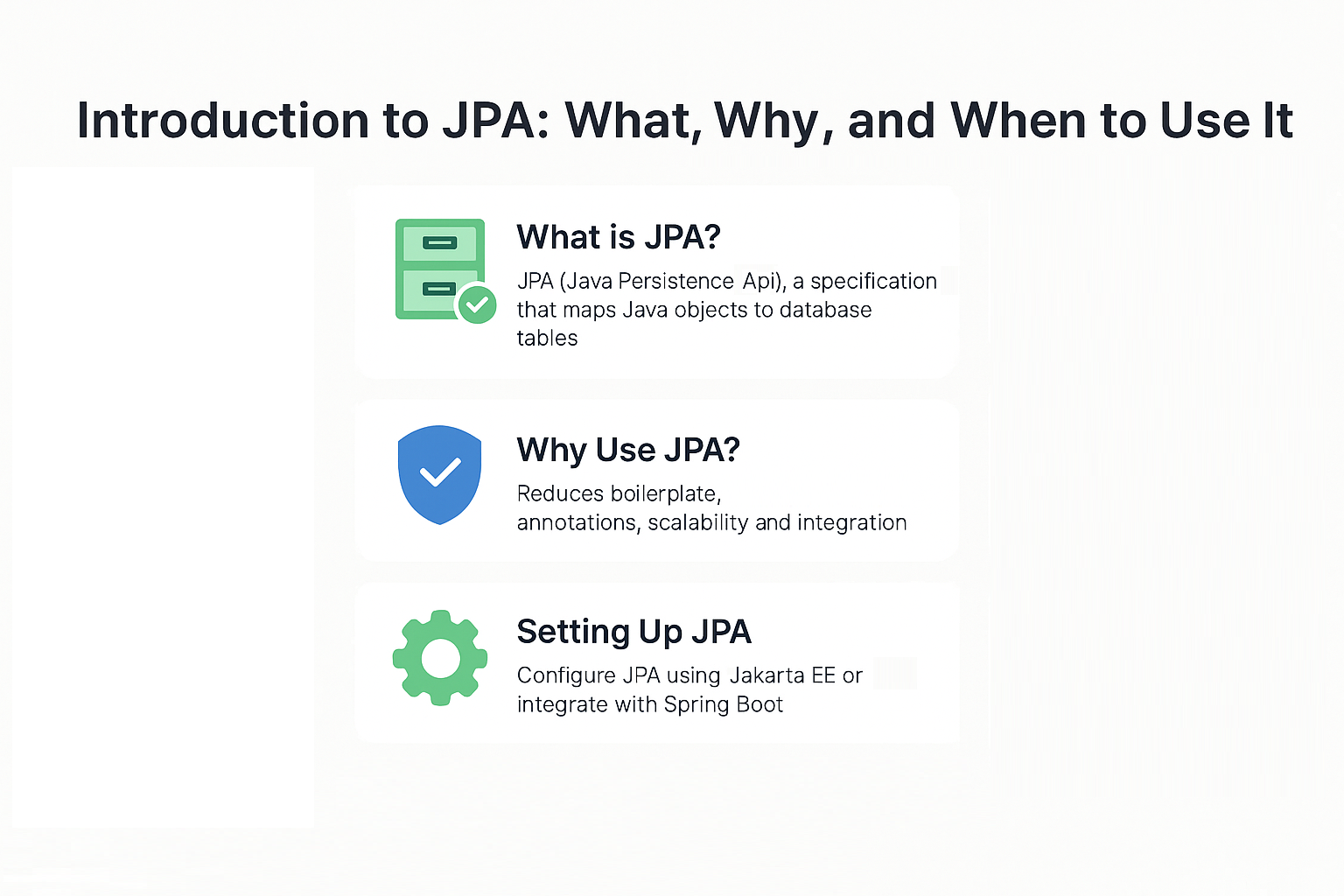Working with relational databases is a common task for Java developers. Traditionally, this was handled with JDBC, requiring manual SQL, connection handling, and tedious object-to-table mapping. This led to excessive boilerplate code and error-prone applications.
The Java Persistence API (JPA) solves this by providing a standard ORM (Object Relational Mapping) framework. With JPA, developers can interact with databases using Java objects instead of writing raw SQL for every operation.
What is JPA?
- JPA (Java Persistence API) is a specification, not an implementation.
- It defines how Java objects (entities) should be mapped to database tables.
- Popular JPA providers: Hibernate, EclipseLink, OpenJPA.
- Think of JPA as the blueprint, while Hibernate or EclipseLink are the actual builders.
Analogy:
Imagine a classroom. The attendance register (database) records students. JPA acts like a teacher’s rulebook for how to manage attendance. The actual teacher (Hibernate, EclipseLink) follows those rules to maintain the register.
Why Use JPA?
- Reduces boilerplate: No need for repetitive JDBC code.
- Portability: Switch providers without rewriting code.
- Productivity: Use annotations instead of writing DDL/SQL.
- Scalability: Handles caching, fetching, and batch operations efficiently.
- Integration: Works seamlessly with Spring Boot, Jakarta EE, and enterprise apps.
When to Use JPA?
Use JPA when:
- Your application frequently interacts with relational databases.
- You want to reduce manual SQL management.
- You need advanced ORM features like lazy loading, cascading, and entity relationships.
- You require cross-provider portability.
Avoid JPA when:
- You need raw SQL performance for analytics-heavy workloads.
- You deal with NoSQL databases (JPA is strictly for relational DBs).
Setting Up JPA
persistence.xml (for Jakarta EE)
<persistence xmlns="http://xmlns.jcp.org/xml/ns/persistence" version="2.1">
<persistence-unit name="examplePU">
<class>com.example.model.User</class>
<properties>
<property name="jakarta.persistence.jdbc.driver" value="org.h2.Driver"/>
<property name="jakarta.persistence.jdbc.url" value="jdbc:h2:mem:testdb"/>
<property name="jakarta.persistence.jdbc.user" value="sa"/>
<property name="jakarta.persistence.jdbc.password" value=""/>
<property name="hibernate.dialect" value="org.hibernate.dialect.H2Dialect"/>
<property name="hibernate.hbm2ddl.auto" value="update"/>
</properties>
</persistence-unit>
</persistence>
Spring Boot Configuration
spring.datasource.url=jdbc:h2:mem:testdb
spring.datasource.username=sa
spring.datasource.password=
spring.jpa.hibernate.ddl-auto=update
spring.jpa.show-sql=true
JPA Annotations and Mapping
Basic Entity
import jakarta.persistence.*;
@Entity
@Table(name = "users")
public class User {
@Id
@GeneratedValue(strategy = GenerationType.IDENTITY)
private Long id;
private String name;
@Column(unique = true)
private String email;
// Getters & Setters
}
Relationships
- One-to-Many
@OneToMany(mappedBy = "user", cascade = CascadeType.ALL, fetch = FetchType.LAZY)
private List<Order> orders;
- Many-to-One
@ManyToOne
@JoinColumn(name = "user_id")
private User user;
CRUD Operations with EntityManager
EntityManagerFactory emf = Persistence.createEntityManagerFactory("examplePU");
EntityManager em = emf.createEntityManager();
// Create
em.getTransaction().begin();
User user = new User();
user.setName("Alice");
user.setEmail("alice@example.com");
em.persist(user);
em.getTransaction().commit();
// Read
User found = em.find(User.class, 1L);
// Update
em.getTransaction().begin();
found.setName("Alice Updated");
em.merge(found);
em.getTransaction().commit();
// Delete
em.getTransaction().begin();
em.remove(found);
em.getTransaction().commit();
em.close();
emf.close();
Querying in JPA
JPQL
List<User> users = em.createQuery("SELECT u FROM User u WHERE u.name = :name", User.class)
.setParameter("name", "Alice")
.getResultList();
Criteria API
CriteriaBuilder cb = em.getCriteriaBuilder();
CriteriaQuery<User> query = cb.createQuery(User.class);
Root<User> root = query.from(User.class);
query.select(root).where(cb.equal(root.get("name"), "Alice"));
List<User> results = em.createQuery(query).getResultList();
Native SQL
List<Object[]> results = em.createNativeQuery("SELECT * FROM users").getResultList();
Fetching Strategies
- Eager: Load related entities immediately.
- Lazy: Load only when accessed (recommended for performance).
Analogy:
Lazy fetching is like ordering food only when you’re hungry, while eager fetching is like ordering everything upfront, even if you may not eat it.
Common Pitfalls and Anti-Patterns
- N+1 Select Problem: Avoid unoptimized lazy fetching.
- Misusing Cascade: Don’t cascade remove unless required.
- Eager Fetch Everywhere: Leads to performance bottlenecks.
Best Practices
- Prefer lazy fetching.
- Use DTOs for read-heavy queries.
- Monitor queries with tools like Hibernate’s SQL logs.
- Use batch fetching to solve N+1 problems.
📌 JPA Version Notes
- JPA 2.0: Introduced Criteria API, Metamodel.
- JPA 2.1: Added stored procedures, entity graphs.
- Jakarta Persistence: Migration from
javax.persistencetojakarta.persistence.
Real-World Integration
With Spring Boot
@Repository
public interface UserRepository extends JpaRepository<User, Long> {
List<User> findByName(String name);
}
Spring Data JPA removes the need for boilerplate CRUD operations.
With Jakarta EE
Use @PersistenceContext to inject EntityManager in enterprise beans.
Conclusion and Key Takeaways
- JPA standardizes database interaction in Java.
- It reduces boilerplate, improves maintainability, and ensures portability.
- Best used in enterprise, microservices, and Spring Boot applications.
- Avoid misuse of eager fetching and unoptimized queries.
FAQ
1. What’s the difference between JPA and Hibernate?
JPA is a specification; Hibernate is one of its implementations.
2. How does JPA handle the persistence context?
It tracks entities like a “classroom register” — keeping entities managed and synchronized.
3. What are the drawbacks of eager fetching in JPA?
It can cause performance issues by loading unnecessary data.
4. How can I solve the N+1 select problem with JPA?
Use JOIN FETCH or entity graphs to prefetch related entities.
5. Can I use JPA without Hibernate?
Yes, with other providers like EclipseLink or OpenJPA.
6. What’s the best strategy for inheritance mapping in JPA?
Depends: SINGLE_TABLE (fastest), JOINED (normalized), TABLE_PER_CLASS (less common).
7. How does JPA handle composite keys?
Using @EmbeddedId or @IdClass.
8. What changes with Jakarta Persistence?
Package changed from javax.persistence → jakarta.persistence.
9. Is JPA suitable for microservices?
Yes, if services use relational databases. Ensure proper transaction boundaries.
10. When should I avoid using JPA?
When dealing with heavy analytics, batch jobs, or NoSQL databases.
